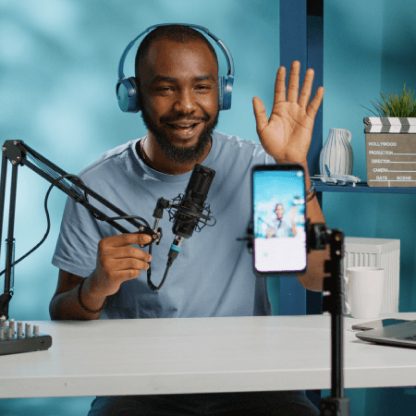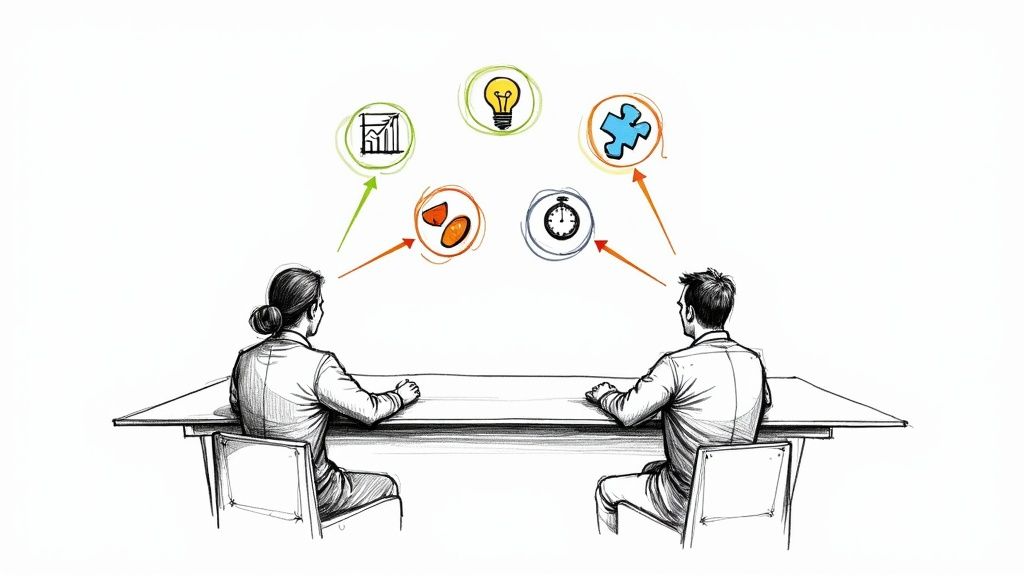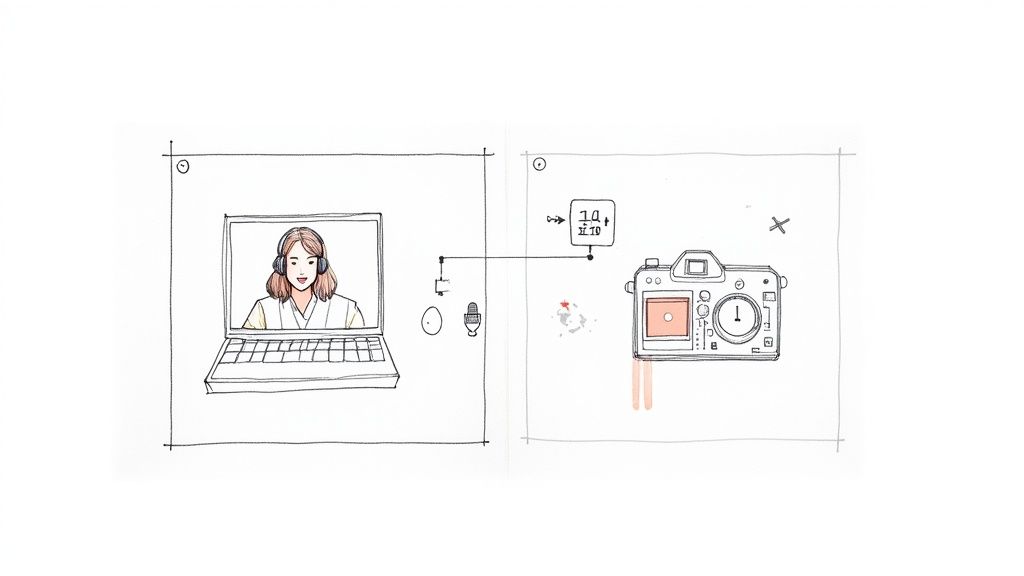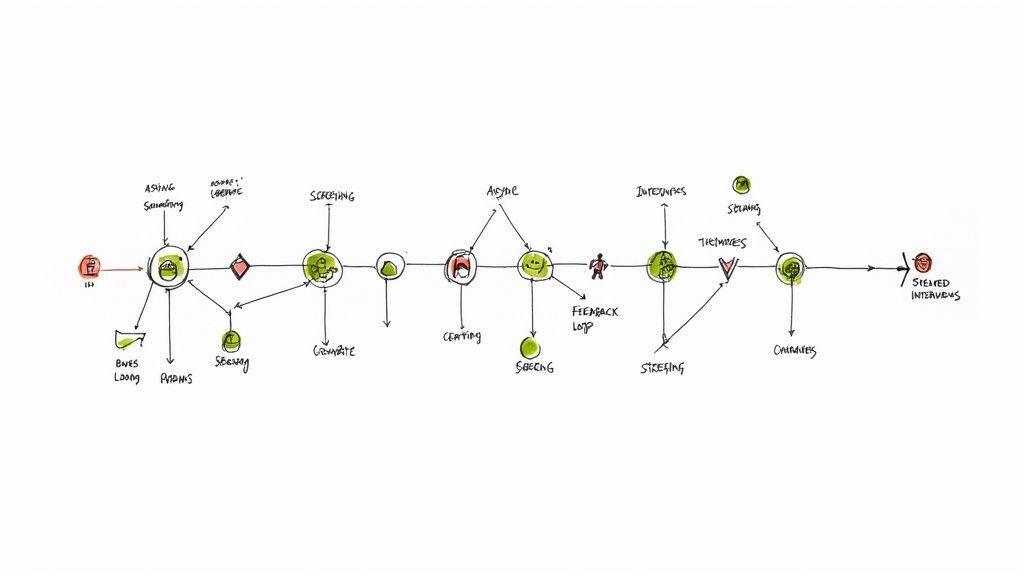In the race for top talent, a slow hiring process isn't just a minor headache—it's a massive business liability that can cost you your best candidates. If you want to reduce time to hire, the game isn't about working harder; it's about replacing the administrative bottlenecks with smarter, tech-driven workflows, especially in those crucial early screening stages.
The High Cost of a Slow Hiring Process
Let's be blunt: when it comes to hiring, speed is your biggest competitive advantage. If your hiring cycle is dragging on for weeks, or even months, you're not just waiting around. You're actively losing.
The most in-demand candidates are often off the market in just 10 days. That means while you're still trying to coordinate schedules, your first-choice applicant has probably already signed an offer with a competitor.
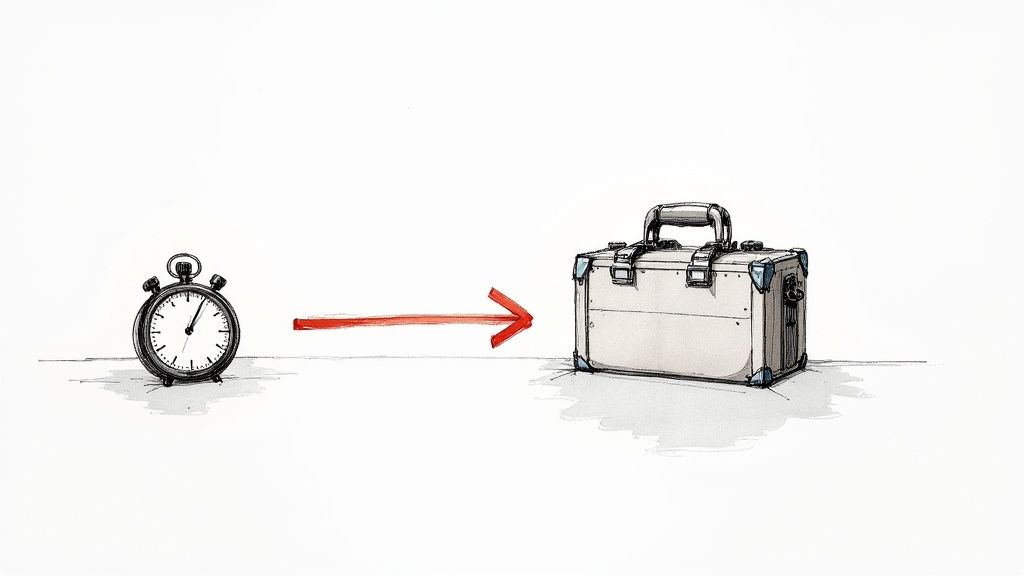
This delay sends ripples across your entire organization. An open role puts a huge strain on your existing team as they scramble to cover the extra work. It doesn't take long for morale to dip, burnout to set in, and for critical projects to grind to a halt.
The Growing Challenge of Administrative Delays
And the problem is only getting worse. A recent Hiring Insights Report revealed that a staggering 60% of companies saw their time-to-hire actually increase last year. That’s a big jump from 44% the year before. Meanwhile, only a tiny 6% managed to speed things up.
So, what's the holdup? A huge part of it is the sheer administrative weight. Recruiters are burning an estimated 35% of their time just scheduling interviews. You can dig into more of the numbers in these recruiting statistics on selectsoftwarereviews.com.
This is the administrative quicksand where so many hiring strategies go to die. The endless email chains, the manual data entry, the back-and-forth—it all adds up, turning hours into days and days into weeks.
The real cost of a slow hiring process isn't just the salary of an unfilled role. It's the lost innovation, the missed deadlines, and the strain on your team that truly impact the bottom line.
Shifting Candidate Expectations
Let's not forget the candidate's perspective. People today expect a hiring experience that’s as smooth and intuitive as ordering a pizza online. They want clear communication, transparency, and a process that respects their time.
When they encounter a clunky, slow, or disorganized hiring journey, it sends a clear message: your company might be just as inefficient on the inside. That kind of damage to your employer brand happens long before they ever talk to a hiring manager.
To genuinely cut down your time to hire, you have to do more than just tinker with the old ways. It demands a fundamental shift in how you think about recruiting:
- Be Proactive, Not Reactive: Build a pipeline of talent continuously. Don't start from scratch every single time a role opens up.
- Embrace the Right Tools: Use technology like asynchronous video interviews to screen candidates on their own time and eliminate the scheduling nightmare.
- Optimize Your Process: Get rid of unnecessary steps. Give your recruiters the freedom to evaluate talent instead of getting bogged down in administrative tasks.
Ultimately, a faster recruitment process isn't just about filling seats more quickly. It’s a strategic imperative for building a resilient, high-performing team that can push your business forward.
Crafting Job Descriptions That Attract the Right People
If you’re serious about slashing your time-to-hire, you have to start at the very beginning: the job description. I’ve seen it countless times—a vague or uninspiring job post goes live, and suddenly, the hiring team is drowning in a sea of mismatched résumés. It's a massive time sink. The real goal isn't just to get applicants; it's to create a magnetic job post that acts as your first, most effective filter.
This is all about quality over quantity. Instead of just rattling off a list of responsibilities, your job description needs to sell the role, the team, and your mission. It should speak directly to the exact person you want to hire, filtering for both hard skills and culture fit from the get-go. A well-written description naturally shrinks the applicant pool to only the most promising people, saving you from hours of pointless screening.
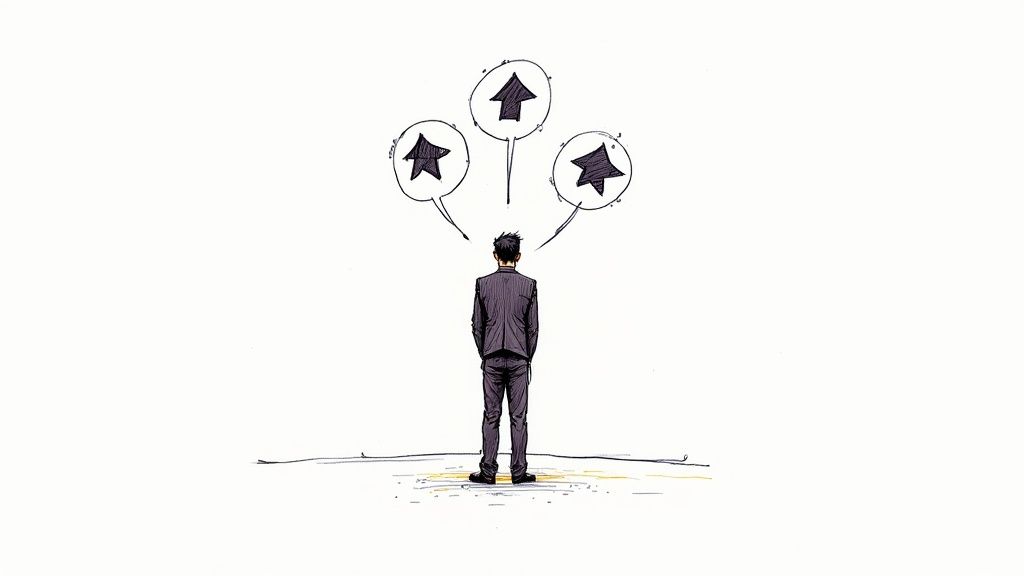
Go Beyond the Standard Template
Let's be honest, most job descriptions are boring. They’re just a sterile list of duties and requirements that all sound the same and do absolutely nothing to excite top talent. To stand out, you need to paint a vivid picture of what success actually looks like in the role.
Stop saying "manage social media." Instead, give it some teeth. Try something like, "Your mission is to develop and execute our social media strategy, growing our community from 10,000 to 50,000 engaged followers in your first year." That single sentence immediately grabs the attention of ambitious, results-driven candidates while repelling those who just want to coast.
A great job description doesn't just describe the work; it issues a challenge. It invites problem-solvers to step up and make a tangible impact, which is a powerful way to filter for proactive talent.
This approach shifts the whole conversation from passive tasks to active achievements. You're telling a story about the role's potential and helping the right candidates see themselves winning in your company.
Use Language That Filters and Attracts
The words you choose matter—a lot. Your goal is to be incredibly clear, specific, and inclusive. Vague language is the enemy because it creates a wide, unqualified applicant pool, which is the exact opposite of what you need to reduce your time-to-hire.
Here are a few small but powerful tweaks I always recommend:
- Swap "Requirements" for "What You'll Bring": It’s a subtle change, but it feels more collaborative and less like a rigid checklist that might scare off perfectly capable people.
- Focus on Impact, Not Just Duties: Instead of a dry task like "Responsible for reports," frame it as, "Create data-driven reports that guide our marketing spend and strategy." This connects the work to a meaningful business outcome.
- Clearly State Must-Haves vs. Nice-to-Haves: Be upfront about what’s non-negotiable versus what’s a bonus. This stops great candidates from self-rejecting just because they don’t tick every single box.
This level of clarity means that the people who ultimately click "apply" have a much more realistic understanding of the role and are far more likely to be a genuine fit.
Build a High-Quality Pipeline Strategically
Once your job description is dialed in, where you post it is just as critical. Blasting it across every major job board is a recipe for inefficiency. A more surgical, targeted approach will always yield a smaller, higher-quality group of applicants.
You need to focus your efforts on the platforms where your ideal candidates are already hanging out.
- Niche Job Boards: If you’re hiring a UX designer, don't just post on generalist sites. Go to boards dedicated specifically to design professionals. You'll find more relevant talent, faster.
- Professional Online Communities: Share the opening in targeted LinkedIn Groups, Slack channels, or industry forums. This is a fantastic way to tap into the passive candidate market—people who aren't actively job hunting but are open to the right opportunity.
- Structured Employee Referral Programs: Your current team is your best source for high-quality candidates, period. Put a formal referral program in place with clear incentives. Referrals consistently have the shortest time-to-hire and the highest retention rates.
By being deliberate about where and how you source, you build a much stronger candidate pool from day one. This front-loaded effort is one of the single most effective ways to reduce time-to-hire and ensures your team spends its time with the people who truly matter.
Using Asynchronous Interviews to Screen Faster
Picture this: you get to slice your initial screening time in half. That’s not some far-off dream; it's a very real outcome for teams that switch to asynchronous video interviews. If your main goal is to reduce time-to-hire without sacrificing the human connection, this is one of the most impactful changes you can make.
The idea is straightforward but incredibly effective. Instead of the back-and-forth email nightmare of coordinating schedules, you send candidates a link with your interview questions. They record their answers whenever it works for them—10 PM on a Tuesday, 7 AM on a Saturday, you name it. Your team can then review those videos on their own schedule.
This simple shift instantly breaks up one of the biggest logjams in hiring: scheduling. It's not a small problem, either. One study found recruiters spend roughly 35% of their time just trying to get interviews on the calendar. Asynchronous interviews completely wipe out that administrative headache for the first round of screening.
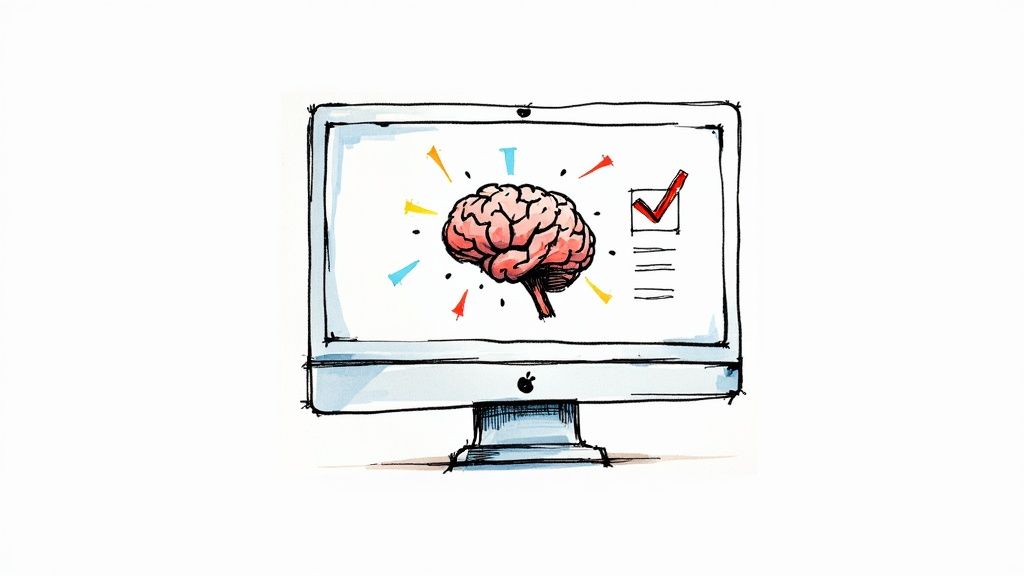
This image perfectly captures the spirit of asynchronous communication. It’s all about flexibility and individual pacing, not forcing everyone into the same real-time box. You're decoupling the interview from a specific time and place, which gives both you and the candidate more control over the process.
Writing Questions That Uncover Real Skills
Here’s the thing: an asynchronous interview is only as good as the questions you ask. Since you can’t jump in with a follow-up, your initial prompts have to be sharp enough to get right to the core of a candidate's skills and personality. Generic questions just won't fly here.
You need to craft questions that get candidates to show you their competence, not just tell you about it.
- Behavioral Questions: Don't ask, "Are you a team player?" Instead, try: "Tell me about a time you had a significant disagreement with a colleague on a project. How did you handle it, and what was the outcome?" This pushes them to share a real-world story.
- Situational Questions: Give them a hypothetical problem they'd actually face in the role. For a customer support job, you might ask: "A customer is angry because their order is late and threatening to cancel. Record your response as if you were speaking to them right now."
- Skill-Based Prompts: For a marketing position, you could say: "You have a $500 budget to promote a new product launch on social media. Briefly walk us through your high-level strategy."
Questions like these provide a much richer, more authentic look into a candidate's problem-solving style, communication skills, and overall demeanor than a flat résumé ever could. For a deeper dive, check out our guide on how to modernize your recruitment process with on-demand asynchronous interviews.
Creating a Positive Candidate Experience
I hear this concern a lot: "Won't this feel robotic or intimidating for candidates?" It’s a valid point, but one you can easily solve with a bit of transparency and thoughtfulness. Protecting your employer brand means making sure this process feels good for the people going through it.
Remember, the candidate experience starts the moment they receive your interview invitation. A process that feels fair, clear, and respectful of their time will set a positive tone for the entire hiring journey.
Here’s how to make sure your process is candidate-friendly:
- Set Clear Expectations: In your invitation, explain why you use this format. Frame it as a way to respect their schedule and give everyone a fair shot. Outline the basics: how many questions, roughly how long it will take, and whether they can re-record answers.
- Provide Technical Guidance: Don’t assume everyone is a tech wiz. Offer a simple guide or a link to a help page. Let them know they’ll need a webcam and microphone, and provide a contact for technical trouble. This small step goes a long way in reducing anxiety.
- Keep It Concise: No one wants to answer 15 pre-recorded questions. Stick to 5-7 questions max. The goal here is a first impression, not an interrogation. Showing you respect their time is crucial.
By framing the video interview as a tool for flexibility and fairness, you can transform what could be a sterile process into a positive brand moment. It shows your company is modern and considerate—and that’s a huge plus for keeping top talent engaged.
How AI And Automation Transform Your Hiring Workflow
Once you’ve embraced tools like asynchronous interviews, the next logical step to seriously cut down your hiring time is bringing in artificial intelligence and automation. These aren't just buzzwords anymore; they’re practical tools that can take on the repetitive, time-draining tasks currently bogging down your recruitment team. This is how you make a real dent in your time-to-hire metrics.
It helps to think of AI not as a replacement for your recruiters, but as their new, incredibly efficient assistant. Its real job is to handle all the manual work that doesn't need a human touch or strategic thinking. This frees up your team to do what they do best: build relationships with candidates, gauge cultural fit, and actually sell your company to top-tier talent.
Automating The Administrative Burden
So much of any hiring process is just plain admin. Manually sifting through hundreds of resumes, checking qualifications against a job description, and pulling together a shortlist is a huge time sink. This is exactly where AI shines, turning what used to be days of work into mere minutes.
AI-powered screening tools can scan applications in an instant, pinpointing the keywords, skills, and experience levels that align with your requirements. Instead of a recruiter burning an entire morning just reading applications, they get a pre-vetted list of the strongest contenders right away. We cover this in more detail in our guide on automated candidate screening.
The real value of AI in recruiting is pure efficiency. It doesn't pick the winner for you. It just hands you a much stronger, pre-filtered pool of talent so you can make smarter decisions, faster.
For talent acquisition pros, using LinkedIn automation tools specifically designed for recruiters can also be a game-changer. These platforms help manage outreach and keep the conversation going, building a proactive sourcing strategy without all the manual clicking. A full talent pipeline is your best defense against long hiring cycles.
A Real-World Impact On Hiring Timelines
The results aren't just theoretical. One study found that tech startups using AI-driven platforms managed to slash their average time-to-hire from 30 days down to just 18 days. That's a 40% reduction. The outlook is even better, with predictions that organizations fully adopting these tools will shorten their hiring cycles by another 15%.
This shows a clear, measurable payoff. The time saved means critical roles get filled faster, which eases the burden on your current team and keeps projects moving forward. This infographic really drives home where so much of that time gets eaten up in the manual interview stages.
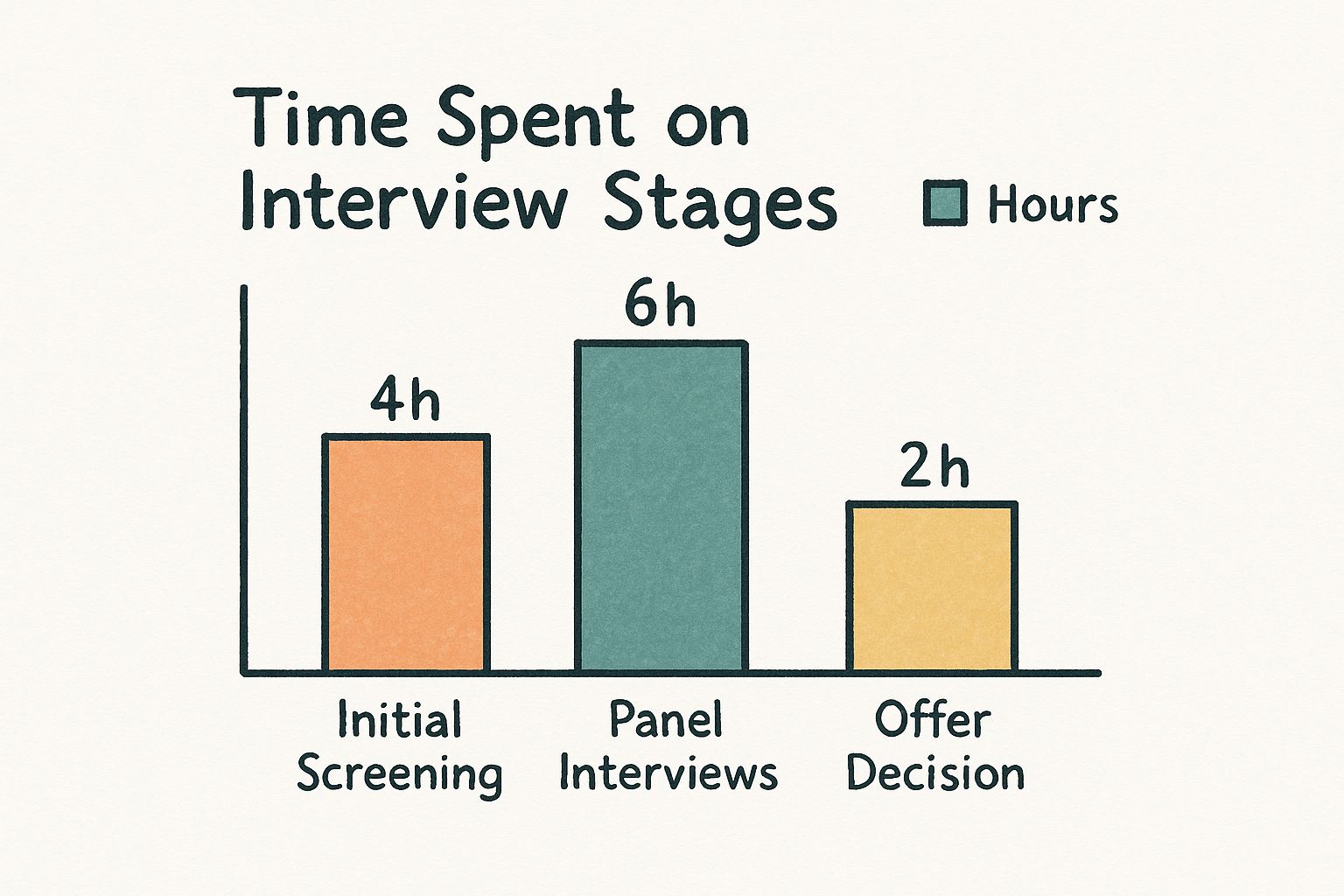
As you can see, initial screenings and panel interviews are the biggest time consumers, which highlights exactly where automation can have the most dramatic effect.
To put this in perspective, here's a direct comparison of how these stages look with and without AI.
Impact of Traditional vs AI-Powered Hiring Methods
This comparison shows how AI integration impacts key recruitment metrics, illustrating the potential for time and resource savings.
| Hiring Stage | Traditional Method (Time Spent) | AI-Powered Method (Time Spent) | Time Reduction |
|---|---|---|---|
| Resume Screening | 5-7 hours per 100 applicants | 15-30 minutes | Over 90% |
| Initial Candidate Sourcing | 8-10 hours per role | 1-2 hours | Over 80% |
| Scheduling Interviews | 2-4 hours per role | 30 minutes (automated) | Over 75% |
| Initial Screening Calls | 10-15 hours (30 min/candidate) | 3-5 hours (asynchronous review) | Over 60% |
The numbers speak for themselves. The cumulative time saved across the initial phases of hiring is substantial, allowing teams to move qualified candidates to final stages much more quickly.
From Data Entry To Data-Driven Decisions
Beyond just automating tasks, AI elevates your hiring from a purely administrative function to a data-driven strategy. By tracking every part of the process, these systems offer up incredible analytics that can shine a light on hidden bottlenecks you never knew you had.
-
Candidate Source Analysis: AI can tell you exactly which channels bring in your best hires. Are your top performers coming from LinkedIn, a niche job board, or employee referrals? Now you’ll know where to focus your budget for the best ROI.
-
Bias Reduction: By focusing only on skills and qualifications in the first pass, AI helps reduce the impact of unconscious bias. It makes sure every single applicant is measured against the same objective standards, which is a huge step toward a more diverse and equitable process.
-
Predictive Insights: More advanced systems can even start to spot patterns in your most successful hires. Over time, the AI learns what combination of skills and experiences leads to long-term success at your company, helping you sharpen your search for future openings.
By bringing these tools into your workflow, you're not just moving faster—you're hiring smarter. You build a more efficient, fair, and strategic recruitment machine that gives you a serious advantage in a tight talent market.
You’ve done the heavy lifting—sourcing, screening, and narrowing your list down to a handful of fantastic candidates. It feels like you're crossing the finish line, but honestly, this is where so many hiring processes completely unravel. The last few steps, like the panel interview and the offer itself, are where momentum dies, and even a tiny delay can cost you your top choice.
To actually reduce time to hire, you have to treat this final leg of the race like a high-stakes, time-sensitive operation. The trick is to stop thinking in a straight line, where one step has to finish before the next can start. Instead, you need to start parallel processing. Every hour matters, and your ability to get people and decisions aligned quickly is your biggest advantage.
https://www.youtube.com/embed/7dhqeJDtiCM
Architecting a Flawless Final Interview
The final interview isn't just another chat. It’s a carefully choreographed event designed to get everyone on the same page and make a confident, final decision. The single biggest mistake I see teams make here is a complete lack of structure. When different interviewers are firing off random, overlapping questions, you end up with a collection of disconnected opinions, not a clear set of comparable data.
Structured interviews are the answer. This means every single candidate for a role gets asked the same core set of behavioral and situational questions by the panel. This consistency is crucial for two big reasons:
- It guarantees a fair and equitable evaluation for every candidate.
- It makes the post-interview discussion incredibly efficient because you're comparing apples to apples.
Instead of a vague, "So, what did you think?" debrief, the conversation shifts to something much more concrete, like, "How did their answer to the project conflict question stack up against Candidate B's?" This focus on specific evidence cuts through a ton of subjectivity and helps the team agree on a final choice much, much faster.
The goal of the final interview isn't just to vet the candidate; it's to gather the specific, comparable data points your team needs to make a swift, unified, and defensible hiring decision.
The Need for Speed in Feedback and Decision-Making
As soon as that final interview ends, the clock is ticking—loudly. Your top candidate is almost certainly in the final stages with other companies. Slow, bureaucratic feedback collection is an absolute momentum killer. Just emailing out forms and hoping everyone replies over the next few days is a perfect recipe for losing your first-choice hire.
You need to build a rapid feedback loop instead. Get a short, 15-minute huddle on the calendar immediately after the final interview wraps up. Pull all the decision-makers into the same room (virtual is fine!) to share their impressions while everything is still fresh.
This immediate debrief accomplishes a few key things:
- It forces a decision: The conversation is focused and built for action.
- It captures fresh insights: Memories and subtle details fade incredibly fast.
- It eliminates follow-up: You won't spend the next two days chasing stakeholders for their thoughts.
To make these quick huddles even more potent, use a standardized evaluation system. A well-designed rubric helps everyone score candidates on the exact same criteria. You can learn more about how to get this right with an effective interview evaluation form, which brings much-needed consistency to your process.
Crafting and Delivering a Winning Offer
Once the hiring team gives you the green light, the offer process has to be fast and flawless. That gap between a verbal "yes" and a written offer letter is a danger zone where candidates start to have second thoughts and competing offers can sneak in.
Automating the creation of documents is a huge help here. Using tools for efficient offer letter generation slashes the time it takes to get from a verbal agreement to a formal one. It eliminates manual errors and ensures a professional-looking offer lands in the candidate’s inbox within hours, not days.
Timing your offer can also be a powerful strategic move. Global hiring data shows that timing really matters, with Tuesday often being the peak day for job posts, applications, and offers. By scheduling your final interviews to align with this, you can extend offers within that peak window, boosting engagement and speeding things up. This is especially critical in competitive markets where some roles attract 5-6 times more applicants than others.
When you make that call with the verbal offer, be ready. Don't just spit out a salary number. Sell the whole opportunity. Reiterate why you’re so excited for them to join the team, touch on the impact their work will have, and highlight a few key benefits. That personal touch reinforces their decision and builds real excitement, making a quick "yes" much more likely.
Of course, even with a solid game plan, shaking up your hiring process to move faster is bound to bring up a few questions. Let's tackle some of the most common concerns we hear from teams. Getting these out in the open will give you the clarity and confidence to move forward and really start to reduce your time-to-hire.
Will Speeding Up The Process Lead To Lower Quality Hires?
This is easily the biggest hesitation we see, and it's a completely fair question. The short answer? No—not if you do it right. The whole point of these strategies isn't to rush the critical, human-centered parts of hiring. It’s about cutting out the administrative dead weight and frustrating delays.
Think of it less like cutting corners and more like clearing the path. A faster process keeps your best candidates genuinely engaged and excited about the role. When you consider that top talent is often off the market in as little as 10 days, a slow, drawn-out process doesn't signal thoroughness—it signals inefficiency. Speeding things up means you actually get a chance to make a decision on top candidates before they've already accepted another offer.
The goal isn't to make rushed decisions; it's to make smart decisions, faster. By using tools like AI screening and structured interviews, you actually introduce more consistency and data into your process, which often leads to higher-quality hires, not lower.
A more efficient workflow frees up your team for what truly matters: conducting in-depth final interviews and having thoughtful deliberation. They can focus on the high-impact work because they aren't bogged down by weeks of scheduling conflicts and mind-numbing manual resume reviews.
How Do I Get Buy-In From Hiring Managers?
Getting your hiring managers on board is absolutely critical. Let's be real—they're often overworked and can be skeptical of any new process that looks like it's just adding more to their plate. The trick is to frame the change around the direct benefits to them and their teams.
Forget leading with the technology; lead with the solution to their headaches.
- Talk about the competitive edge: Frame this as a strategic move to secure the best people for their team, not just an HR metric.
- Show them the data: Bring concrete numbers to the table. Pointing out that recruiters can spend 35% of their time just on scheduling is often an eye-opening statistic for a busy manager.
- Focus on filling the empty seat: Every day a role on their team is vacant, the rest of their people are picking up the slack. A faster process means their team gets the support it needs sooner, which reduces burnout and keeps their projects moving forward.
My best advice? Start small. Kick things off with a pilot program for one or two open positions. When you can go back to them with a clear success story—"Hey, we filled this position 40% faster with this method"—you’ll build powerful momentum that’s pretty hard to argue with.
Are AI Recruiting Tools Difficult or Expensive to Implement?
The term "AI" can sound pretty intimidating, conjuring up images of complex and expensive systems. But the reality of modern recruitment tech is far more accessible than you might think. Many of today's best tools are built to be user-friendly and integrate smoothly with the Applicant Tracking System (ATS) you already have.
And while there's an investment, you have to weigh it against the very real and significant costs of a sluggish hiring process. Just think about it:
- The cost of a lost candidate: What’s the business impact when your top choice gets snapped up by a competitor?
- Lost productivity: How much value is lost for every single week a critical role sits empty?
- Recruiter inefficiency: What's the cost of your talent team spending over a third of their time on low-value administrative work?
When you look at it through that lens, the ROI on these tools becomes incredibly clear. Plus, many providers, like us at Async Interview, offer scalable pricing models. This means everyone from high-growth startups to large enterprises can find a plan that fits their budget. This kind of technology is no longer a luxury for massive corporations; it's a practical solution for any team that's serious about winning top talent.
Ready to eliminate scheduling bottlenecks and start shortlisting top candidates in a fraction of the time? Async Interview makes it easy. Discover how our asynchronous video platform can help you hire up to 10x faster.
